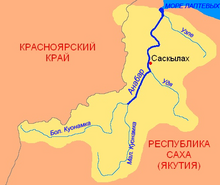Anabar River
| Anabar River | |
|---|---|

Anabar river basin
|
|
| Country | Russia |
| Basin features | |
| Main source | Anabar Plateau |
| River mouth | Laptev Sea |
| Basin size | 100,000 km2 (39,000 sq mi) |
| Physical characteristics | |
| Length | 939 km (583 mi) |
| Discharge |
|
Coordinates: 71°37′55″N 113°54′00″E / 71.632°N 113.900°E
The Anabar River (Russian: Анабар) is a river in Sakha, Russia, located just west of the Lena River. Its catchment extends into the Putoran Mountains that form the highest part of the Central Siberian Plateau.
Its mean annual discharge is approximately 500 cubic metres per second (18,000 cu ft/s), concentrated heavily in early summer when the ice that covers the river for most of the year thaws. The Gulf of Anabar is believed to be the easternmost fjord in Russia – defining the point at which the climate during the Last Glacial Maximum became too dry for glaciers to form. A clear transition from fjords to deltas at river mouths is apparent shortly to the east at the Lena River delta.
The basin of the Anabar river is notable as the location of the largest concentration of diamond deposits in the world outside of Africa and Australia. These deposits made the Soviet Union into one of the world's largest producers of diamonds, and remain the economic mainstay of the area.
...
Wikipedia
